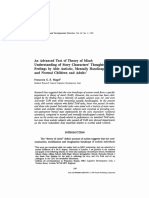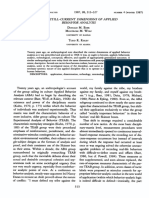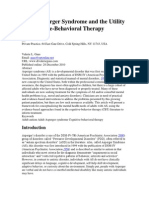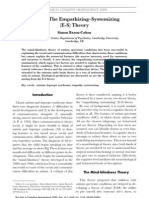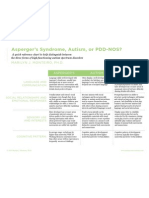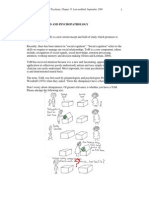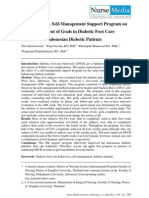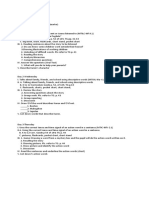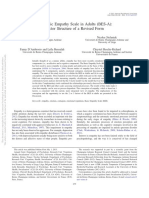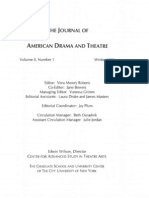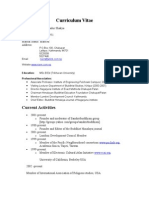Baron-Cohen Theories of The Autistic Mind 2008
Baron-Cohen Theories of The Autistic Mind 2008
Uploaded by
Fris Guinnea SwasonoCopyright:
Available Formats
Baron-Cohen Theories of The Autistic Mind 2008
Baron-Cohen Theories of The Autistic Mind 2008
Uploaded by
Fris Guinnea SwasonoOriginal Description:
Original Title
Copyright
Available Formats
Share this document
Did you find this document useful?
Is this content inappropriate?
Copyright:
Available Formats
Baron-Cohen Theories of The Autistic Mind 2008
Baron-Cohen Theories of The Autistic Mind 2008
Uploaded by
Fris Guinnea SwasonoCopyright:
Available Formats
ARTICLE
Theories of the autistic mind
Simon Baron-Cohen, winner of the Societys Presidents Award, outlines a career at the forefront of thinking over autism and Aspergers syndrome
The challenge has been to explain all of the features of autism, across all individuals on the autistic spectrum. After 25 years of careful testing, Simon Baron-Cohen concludes that 'mindblindness' or difficulties with empathy can explain the social-communication difficulties in autism, whilst the newer concept of 'hypersystemising' can explain the areas of strength in autism: excellent attention to detail, and unusually narrow interests.
How can one characterise the differences between those with and without autism? And what implications does such a characterisation have for clinical intervention and special education?
www.autismresearchcentre.com www.researchautism.org www.nas.org.uk Baron-Cohen, S. (2003). The essential difference. Harmondsworth: Penguin.
lassic autism and Aspergers syndrome both share three core diagnostic features: difficulties in social development, and in the development of communication, alongside unusually strong, narrow interests and repetitive behaviour. Since communication is always social, it might be more fruitful to think of autism and Aspergers syndrome as sharing features in two broad areas: socialcommunication, and narrow interests/repetitive actions. As for distinguishing features, a diagnosis of Aspergers syndrome requires that the child spoke on time and has average IQ or above. Today the notion of an autistic spectrum is no longer defined by any sharp separation from normality (Wing, 1997). The clearest way of seeing this normal distribution of autistic traits is using the Autism Spectrum Quotient (or AQ) (Baron-Cohen et al., 2006; Baron-Cohen, Wheelwright, Skinner et al., 2001). This is a screening instrument in the form of a questionnaire, either completed by a parent about their child, or by self-report (if the adult is high-functioning). There are 50 items in total, and when administered to a large population the results resemble a normal distribution. Most people without a diagnosis fall in the range 025; most with a diagnosis of an autism spectrum condition fall between 26 and 50. Of those with an autistic spectrum condition, 80 per cent score above 32, and 99 per cent above 26. So the AQ neatly separates the groups 93 per cent of the general population fall in the average range of the AQ, and 99 per cent of the autistic population fall in the extreme (high-end) of the scale.
In the general population, males score slightly (but statistically significantly) higher than females. Since autism spectrum conditions are far more common in males than in females (classic autism occurs in four males for every one female, and Aspergers syndrome occurs in nine males for every one female), this may suggest that the number of autistic traits a person has is connected to a sex-linked biological factor genetic or hormonal, or both (Baron-Cohen et al., 2005; Baron-Cohen et al., 2004). These two aspects the autistic spectrum and the possibility of sex-linked explanations have been at the core of my research and theorising over recent years.
The mindblindness theory
In my early work I explored the theory that children with autism spectrum conditions are delayed in developing a theory of mind (ToM): the ability to put oneself into someone elses shoes, to imagine their thoughts and feelings (Baron-Cohen, 1995; Baron-Cohen et al., 1985). When we mindread or mentalise, we not only make sense of another persons behaviour (why did their head swivel on their neck? Why did their eyes move left?), but we also imagine a whole set of mental states (they have seen something of interest, they know something or want something) and we can predict what they might do next. The mindblindness theory proposes that children with autism and Aspergers syndrome are delayed in the development of their ToM, leaving them with degrees of mindblindness. As a consequence, they find other peoples behaviour confusing and unpredictable, even frightening. Evidence for this comes from difficulties they show at each point in the development of the capacity to mindread: I A typical 14-month-old shows joint attention (such as pointing or following another persons gaze), during which they not only look at another persons face and eyes, but pay attention to what the other person is interested in (Scaife & Bruner, 1975). Children with autism and Aspergers syndrome show reduced
references
resources
questions
Baron-Cohen, S. (1987). Autism and symbolic play. British Journal of Developmental Psychology, 5, 139148. Baron-Cohen, S. (1992). Out of sight or out of mind: Another look at deception in autism. Journal of Child Psychology and Psychiatry, 33, 11411155. Baron-Cohen, S. (1995). Mindblindness: an essay on autism and theory of mind. Boston: MIT Press/Bradford Books.
Baron-Cohen, S. (2002). The extreme male brain theory of autism. Trends in Cognitive Science, 6, 248254. Baron-Cohen, S. (2003). The essential difference: Men, women and the extreme male brain. London: Penguin. Baron-Cohen, S. (2006). The hypersystemizing, assortative mating theory of autism. Progress in Neuropsychopharmacology and
Biological Psychiatry, 30, 865872. Baron-Cohen, S. (2007a). I cannot tell a lie. In Character, 3, 5259. Baron-Cohen, S. (2007b). Transported into a world of emotion. The Psychologist, 20, 7677. Baron-Cohen, S. & Goodhart, F. (1994). The "seeing leads to knowing" deficit in autism: The Pratt and Bryant probe. British Journal of Developmental Psychology, 12,
397402. Baron-Cohen, S., Hoekstra, R.A., Knickmeyer, R. & Wheelwright, S. (2006). The Autism-Spectrum Quotient (AQ)-Adolescent version. Journal of Autism & Developmental Disorders, 36, 343350. Baron-Cohen, Jolliffe, T., Mortimore, C. & Robertson, M. (1997). Another advanced test of theory of mind: Evidence from very high functioning
112
vol 21 no 2
february 2008
autism
frequency of joint attention, in toddlerhood (Swettenham et al., 1998). The typical 24-month-old engages in pretend play, using their mindreading skills to be able to understand that in the other persons mind, they are just
Aspergers syndrome are delayed in passing this test (Baron-Cohen et al., 1985). Deception is easily understood by the typical four-year-old child (Sodian & Frith, 1992). Children with autism and
tests far more difficult (Baron-Cohen, Wheelwright, Scahill et al., 2001), and the same is true when the adult version of the test is used. Adults with autism and Aspergers syndrome score below average on this test of advanced mindreading (Baron-Cohen, Wheelwright, Hill et al., 2001). A strength of the mindblindness theory is that it can make sense of the social and communication difficulties in autism and Aspergers syndrome, and that it is universal in applying to all individuals on the autistic spectrum. Its shortcoming is that it cannot account for the non-social features. A second shortcoming of this theory is that whilst mindreading is one component of empathy, true empathy also requires an emotional response to another persons state of mind (Davis, 1994). Many people on the autistic spectrum also report that they are puzzled by how to respond to another persons emotions (Grandin, 1996). A final limitation of the mindblindness theory is that a range of clinical conditions show forms of mindblindness, such as patients with schizophrenia (Corcoran & Frith, 1997) or narcissistic and borderline personality disorders (Fonagy, 1989), or children with conduct disorder (Dodge, 1993), so this may not be specific to autism and Aspergers syndrome. Two key ways to revise this theory have been to explain the non-social areas of strength by reference to a second factor, and to broaden the concept of ToM to include an emotional reactivity dimension. Both of these revisions were behind the development of the next theory.
sarcastic
stern
suspicious
pretending (Leslie, 1987). Children with autism and Aspergers syndrome show less pretend play, or their pretence is limited to more rule-based formats (Baron-Cohen, 1987). The typical three-year-old child can pass the seeing leads to knowing test: understanding that merely touching a box is not enough to know what is inside (Pratt & Bryant, 1990). Children with autism and Aspergers syndrome are delayed in this (Baron-Cohen & Goodhart, 1994). The typical four-year-old child passes the false belief test, recognising when someone else has a mistaken belief about the world (Wimmer & Perner, 1983). Most children with autism and
dispirited
Aspergers syndrome tend to assume everyone is telling the truth, and may be shocked by the idea that other people may not say what they mean (BaronCohen, 1992; Baron-Cohen, 2007a). The typical nine-year-old can figure out what might hurt anothers feelings and what might therefore be better left unspoken faux pas. Children with Aspergers syndrome are delayed by around three years in this skill, despite their normal IQ (Baron-Cohen, ORiordan et al., 1999). The typical nine-year-old can interpret another persons expressions from their eyes, to figure out what they might be thinking or feeling. Children with Aspergers syndrome tend to find such
The empathising-systemising (E-S) theory
This newer theory explains the social and communication difficulties in autism and Aspergers syndrome by reference to delays and deficits in empathy, whilst explaining the areas of strength by reference to intact or even superior skill in systemising (BaronCohen, 2002).
adults with autism or Asperger Syndrome. Journal of Child Psychology and Psychiatry, 38, 813822. Baron-Cohen, S., Knickmeyer, R. & Belmonte, M.K. (2005). Sex differences in the brain: Implications for explaining autism. Science, 310, 819823. Baron-Cohen, S., Leslie, A.M. & Frith, U. (1985). Does the autistic child have a
'theory of mind'? Cognition, 21, 3746. Baron-Cohen, S., Leslie, A.M. & Frith, U. (1986). Mechanical, behavioural and Intentional understanding of picture stories in autistic children. British Journal of Developmental Psychology, 4, 113125. Baron-Cohen, S., Lutchmaya, S. & Knickmeyer, R. (2004). Prenatal testosterone in mind: Amniotic fluid studies. Cambridge, MA:
MIT/Bradford Books. Baron-Cohen, S., O'Riordan, M., Jones, R., Stone, V. & Plaisted, K. (1999). A new test of social sensitivity. Journal of Autism and Developmental Disorders, 29, 407418. Baron-Cohen, S., Richler, J., Bisarya, D., Gurunathan, N. & Wheelwright, S. (2003). The Systemising Quotient (SQ). Philosophical Transactions of the Royal Society, 358, 361374.
Baron-Cohen, S., Wheelwright, S., Hill, J., Raste, Y. & Plumb, I. (2001). The 'Reading the Mind in the Eyes' Test revised version. Journal of Child Psychology and Psychiatry, 42, 241252. Baron-Cohen, S., Wheelwright, S., Scahill, V., Lawson, J. & Spong, A. (2001). Are intuitive physics and intuitive psychology independent? Journal of Developmental and
read discuss contribute at www.thepsychologist.org.uk
113
autism
ToM is just the cognitive component of empathy. The second component of empathy is the response element: having an appropriate emotional reaction to another persons thoughts and feelings. This is referred to affective empathy (Davis, 1994). On the Empathy Quotient (EQ), a questionnaire either filled out by an adult about themselves, or by a parent about their child, both cognitive empathy and affective empathy are assessed. On this scale, people with autism spectrum conditions score lower than comparison groups. According to the empathisingsystemising (E-S) theory, autism and Aspergers syndrome are best explained not just with reference to empathy (below average) but Some people have a drive to analyse natural systems such as the tides also with reference to a second psychological factor (systemising), In all these cases, you systemise by noting which is either average or even above above average on a test of how to figure regularities (or structure) and rules. The average. So it is the discrepancy between E out how a Polaroid camera works (Leslie rules tend to be derived by noting whether and S that determines whether you are likely & Thaiss, 1992), even though they have A and B are associated in a systematic way. to develop an autism spectrum condition. difficulties figuring out peoples thoughts The evidence for intact or even unusually To understand this theory we need to and feelings (Baron-Cohen et al., 1985; strong systemising in autism and Aspergers turn to this second factor, the concept of Perner et al., 1989). Both of these are signs syndrome is that, in one study, such systemising the drive to analyse or of their intact or even strong systemising. children performed above the level that one construct any kind of system. What defines The strength of the E-S theory is that would expect on a physics test (Barona system is that it follows rules, and when it is a two-factor theory that can explain the Cohen, Wheelwright et al., 2001). Children we systemise we are trying to identify the cluster of both the social and non-social with Aspergers syndrome as young as 811 rules that govern the system, in order to features in autism spectrum conditions. years old scored higher than a comparison predict how that system will behave (BaronBelow-average empathy is a simple way group who were older (typical teenagers). Cohen, 2006). These are some of the major to explain the social-communication A second piece of evidence comes from kinds of system: difficulties, whilst average or even aboveI collectible systems (e.g. distinguishing studies using the Systemising Quotient (SQ). average systemising is a way of explaining between types of stones or wood), The higher your score, the stronger your the narrow interests, repetitive behaviour, I mechanical systems (e.g. a video-recorder drive to systemise. People with highand resistance to change/need for sameness. or a window lock), functioning autism or Aspergers syndrome This is because when you systemise, it is I numerical systems (e.g. a train timetable score higher on the SQ compared to people easiest to keep everything constant, and only or a calendar), in the general population (Baron-Cohen et vary one thing at a time. That way, you can I abstract systems (e.g. the syntax of a al., 2003). The above tests of systemising see what might be causing what, rendering language, or musical notation), were designed for children or adults with the world predictable. I natural systems (e.g. the weather Aspergers syndrome, not classic autism. When this theory first came out, one patterns, or tidal patterns), However, children with classic autism criticism of it was that it might only apply to I social systems (e.g. a management perform better than controls on the Picture the high-functioning individuals with autism hierarchy, or a dance routine with a Sequencing Test where the stories can be or Aspergers syndrome. Whilst their dance partner) sequenced using physical-causal concepts obsessions (with computers or maths, for I motoric systems (e.g. throwing a Frisbee). (Baron-Cohen et al., 1986). They also score example) could be seen in terms of strong
Learning Disorders, 5, 4778. Baron-Cohen, S., Wheelwright, S., Skinner, R., Martin, J. & Clubley, E. (2001). The Autism Spectrum Quotient (AQ). Journal of Autism and Developmental Disorders, 31, 517. Baron-Cohen, S., Wheelwright, S., Stone, V. & Rutherford, M. (1999). A mathematician, a physicist, and a computer scientist with Asperger Syndrome: Performance on folk
psychology and folk physics test. Neurocase, 5, 475483. Corcoran, R. & Frith, C. (1997). Conversational conduct and the symptoms of schizophrenia. Cognitive Neuropsychiatry, 1, 305318. Davis, M.H. (1994). Empathy: A social psychological approach. Boulder, CO: Westview Press. Dodge, K.A. (1993). Social-cognitive mechanisms in the development of
conduct disorder and depression. Annual Review of Psychology, 44, 559584. Fonagy, P. (1989). On tolerating mental states: Theory of mind in borderline personality. Bulletin of the Anna Freud Centre, 12, 91115. Frith, U. (1989). Autism: Explaining the enigma. Oxford: Blackwell. Golan, O., Baron-Cohen, S., Wheelwright, S. & Hill, J.J. (2006). Systemising
empathy: Teaching adults with Asperger syndrome to recognise complex emotions using interactive multi-media. Development and Psychopathology, 18, 589615. Goldenfeld, N., Baron-Cohen, S. & Wheelwright, S. (2005). Empathizing and systemizing in males, females and autism. Clinical Neuropsychiatry, 2, 338345. Grandin, T. (1996). Thinking in pictures.
114
vol 21 no 2
february 2008
autism
systemising (Baron-Cohen et al., 1999), surely this didnt apply to the lowfunctioning individuals? However, when we think of a child with autism, many of the classic behaviours can be seen as a reflection of their strong systemising (see box opposite). Like the weak central coherence (WCC) theory (Frith, 1989), the E-S theory is about a different cognitive style (Happ, 1996). Like that theory, it also posits excellent attention to detail (in perception and memory), since when you systemise you have to pay attention to the tiny details. This is because each tiny detail in a system might have a functional role. Excellent attention to detail in autism has been repeatedly demonstrated (Jolliffe & Baron-Cohen, 2001; ORiordan et al., 2001; Shah & Frith, 1983, 1993). The difference between these two theories is that whilst the WCC theory sees people with autism spectrum conditions as drawn to detailed information (sometimes called local processing) for negative reasons (an alleged inability to integrate), the E-S theory sees this same quality (excellent attention to detail) as being highly purposeful: it exists in order to understand a system. Attention to detail is occurring for positive reasons: in the service of achieving an ultimate understanding of a system (however small and specific that system might be). Whereas the WCC theory predicts that people with autism or Aspergers syndrome will be forever lost in the detail, never achieving an understanding of the system as a whole (since this would require a global overview), the E-S theory predicts that over time, the person may achieve an excellent understanding of a whole system, given the opportunity to observe and control all the variables in that system. The existence of talented mathematicians with Aspergers syndrome, like Richard Borcherds, is proof that such individuals can integrate the details into a true understanding of the system (Baron-Cohen, 2003). It is worth noting that the executive dysfunction (ED) theory (e.g. Ozonoff et al., 1991) has even more difficulty in explaining instances of good understanding of a whole system, such
as calendrical calculation, or indeed of why the so-called obsessions in autism and Aspergers syndrome should centre on systems at all. So, when the low-functioning person with classic autism has shaken a piece of string thousands of times close to his eyes, whilst the ED theory sees this as perseveration arising from some neural dysfunction which would normally enable the individual to shift attention, the E-S theory sees the same behaviour as a sign that the individual understands the physics of that string movement. He may be able to
make it move in exactly the same way every time. When he makes a long, rapid sequence of sounds, he may know exactly that acoustic pattern, and get some pleasure from the confirmation that the sequence is the same every time. Much as a mathematician might feel an ultimate sense of pleasure at the golden ratio, so the child even with low-functioning autism who produces the same outcome every time with their repetitive behaviour, appears to derive some emotional pleasure at the predictability of the world. This may be what is clinically described as stimming (Wing, 1997).
Examples of systemising in classic autism and/or Aspergers syndrome (italics)
Sensory systemising Motoric systemising Collectible systemising Numerical systemising Motion systemising Spatial systemising Environmental systemising Social systemising Tapping surfaces, or letting Insisting on the same foods each day sand run through ones fingers Spinning round and round, or rocking back and forth Collecting leaves or football stickers Obsessions with calendars or train timetables Watching washing machines spin round and round Obsessions with routes Insisting on toy bricks being lined up in an invariant order Saying the first half of a phrase or sentence and waiting for the other person to complete it Learning knitting patterns or a tennis technique Making lists and catalogues Solving maths problems Analysing exactly when a specific event occurs in a repeating cycle Developing drawing techniques Insisting that nothing is moved from its usual position Insisting on playing the same game whenever a child comes to play
Natural systemising
Asking over and over again Learning the Latin names of every what the weather will be today plant and their optimal growing conditions Mechanical systemising Learning to operate the VCR Fixing bicycles or taking apart gadgets and reassembling them Vocal/auditory/verbal systemising Systemising action sequences Musical systemising Echoing sounds Watching the same video over and over again Playing the same tune over and over again Collecting words and word meanings Analysing dance techniques Analysing the musical structure of a song
Vancouver, WA: Vintage Books. Happ, F. (1996). Autism. London: UCL Press. Jolliffe, T. & Baron-Cohen, S. (1997). Are people with autism or Asperger's syndrome faster than normal on the Embedded Figures Task? Journal of Child Psychology and Psychiatry, 38, 527534. Jolliffe, T. & Baron-Cohen, S. (2001). A test of central coherence theory: Can
adults with high functioning autism or Asperger syndrome integrate fragments of an object. Cognitive Neuropsychiatry, 6, 193216. Kanner, L. (1943). Autistic disturbance of affective contact. Nervous Child, 2, 217250. Leslie, A.M. (1987). Pretence and representation: the origins of theory of mind. Psychological Review, 94, 412426.
Leslie, A.M. & Thaiss, L. (1992). Domain specificity in conceptual development: Neuropsychological evidence from autism. Cognition, 43, 225251. O'Riordan, M., Plaisted, K., Driver, J. & Baron-Cohen, S. (2001). Superior visual search in autism. Journal of Experimental Psychology: Human Perception and Performance, 27, 719730. Ozonoff, S., Pennington, B. & Rogers, S.
(1991). Executive function deficits in high-functioning autistic children: relationship to theory of mind. Journal of Child Psychology and Psychiatry, 32, 10811106. Perner, J., Frith, U., Leslie, A.M. & Leekam, S. (1989). Exploration of the autistic childs theory of mind: Knowledge, belief, and communication. Child Development, 60, 689700.
read discuss contribute at www.thepsychologist.org.uk
115
autism
Autism was originally described as involving resistance to change and need for sameness (Kanner, 1943), and here we see that important clinical observation may be the hallmark of strong systemising. One final advantage of the E-S theory is that it can explain what is sometimes seen as an inability to generalise in autism spectrum conditions (Plaisted et al., 1998; Rimland, 1964; Wing, 1997). According to the E-S theory, this is exactly what you would expect if the person is trying to understand each system as a unique system. A good systemiser is a splitter, not a lumper, since lumping things together can lead to missing key differences that enable you to predict how these two things behave differently.
The extreme male brain theory
The E-S theory has been extended into the extreme male brain (EMB) theory of autism (Baron-Cohen, 2002). This is because there are clear sex differences in empathising (females performing better on many such tests) and in systemising (males performing better on tests of this). Autism and Aspergers syndrome can be seen as an extreme of the typical male profile, a view first put forward by the paediatrician Hans Asperger. To see how this theory is effectively just an extension of the E-S theory, one needs to understand that that theory posits two independent dimensions (E for empathy and S for systemising) in which individual differences are observed in the population. When you plot these, five different brain types are seen: I Type E (E > S): individuals whose empathy is stronger than their systemising. I Type S (S > E): individuals whose systemising is stronger than their empathy. I Type B (S = E): individuals whose empathy is as good (or as bad) as their systemising. (B stands for balanced). I Extreme Type E (E >> S): individuals whose empathy is above average, but who are challenged when it comes to systemising.
males than in females (e.g. the anterior cingulate, superior temporal gyrus, prefrontal cortex and thalamus), people with autism have even smaller brain regions than typical males. In contrast, in regions of the The E-S model predicts that more females brain that on average are bigger in males have a brain of Type E, and more males than in females (e.g. the amygdala and have a brain of Type S. People with autism cerebellum), people with autism have even spectrum conditions, if they are an extreme bigger brain regions than typical males. Also, of the male brain, are predicted to be more the male brain on average is larger than in likely to have a brain females, and people with of Extreme Type S. If autism have been found to one gives people in have even larger brains than E-S theory sees excellent the general population typical males. Not all studies attention to detail as being measures of empathy support this pattern but highly purposeful and systemising (the some do, and it will be EQ and SQ), the important to study such results fit this model patterns further. reasonably well. The majority of males In summary, the EMB theory is (54 per cent) do have a brain of Type S, relatively new and may be important for whereas the largest group of females (44 understanding why more males develop per cent) have a brain of Type E, and the autism and Aspergers syndrome than do majority of people with autism and females. It remains in need of further Aspergers syndrome (65 per cent) have an examination. It extends the E-S theory, extreme of the male brain (Goldenfeld et which has the power to explain not just al., 2005). the social-communication deficits in autism Apart from the evidence from the SQ spectrum conditions, but also the uneven and EQ, there is other evidence that cognitive profile, repetitive behaviour, islets supports the EMB theory. Regarding tests of of ability, savant skills, and unusual narrow empathy, on the faux pas test, where a child interests that are part of the atypical has to recognise when someone has said neurology of this subgroup in the something that could be hurtful, girls population. The E-S theory has implications typically develop faster than boys, and for intervention, as is being tried by children with autism spectrum conditions systemising empathy, presenting emotions develop even slower than typical boys in an autism-friendly format (Baron-Cohen, (Baron-Cohen et al., 1999). On the Reading 2007b; Golan et al., 2006). Finally, the E-S the Mind in the Eyes Test, on average theory destigmatises autism and Aspergers women score higher than men, and people syndrome, relating these to individual with autism spectrum conditions score even differences we see in the population lower than typical males (Baron-Cohen et (between the sexes, and within the sexes), al., 1997). Regarding tests of attention to rather than as categorically distinct or detail, on the Embedded Figures Test, where mysterious. one has to find a target shape as quickly as possible, on average males are faster than females, and people with autism are even I Simon-Baron Cohen faster than typical males (Jolliffe & Baronis Professor of Cohen, 1997). Developmental Recently, the extreme male brain theory Psychopathology at the has been extended to the level of neurology, Autism Research Centre, with some interesting findings emerging Cambridge University. (Baron-Cohen et al., 2005). Thus, in regions sb205@cam.ac.uk of the brain that on average are smaller in
I
Extreme Type S (S >> E): individuals whose systemising is above average, but who are challenged when it comes to empathy.
Plaisted, K., O'Riordan, M. & BaronCohen, S. (1998). Enhanced visual search for a conjunctive target in autism. Journal of Child Psychology and Psychiatry, 39, 777783. Pratt, C. & Bryant, P. (1990). Young children understand that looking leads to knowing (so long as they are looking into a single barrel). Child Development, 61, 973983. Rimland, B. (1964). Infantile autism: The
syndrome and its implications for a neural theory of behaviour. New York: Appleton-Century-Crofts. Scaife, M. & Bruner, J. (1975). The capacity for joint visual attention in the infant. Nature, 253, 265266. Shah, A. & Frith, U. (1983). An islet of ability in autism. Journal of Child Psychology and Psychiatry, 24, 613620. Shah, A. & Frith, U. (1993). Why do autistic individuals show superior
performance on the block design test? Journal of Child Psychology and Psychiatry, 34, 13511364. Sodian, B. & Frith, U. (1992). Deception and sabotage in autistic, retarded, and normal children. Journal of Child Psychology and Psychiatry, 33, 591606. Swettenham, J., Baron-Cohen, S., Charman, T. et al. (1998). The frequency and distribution of
spontaneous attention shifts between social and non-social stimuli in autistic, typically developing, and non-autistic developmentally delayed infants. Journal of Child Psychology and Psychiatry, 9, 747753. Wimmer, H. & Perner, J. (1983). Beliefs about beliefs. Cognition, 13, 103128. Wing, L. (1997). The autistic spectrum: Oxford: Pergamon.
116
vol 21 no 2
february 2008
You might also like
- Technical Manual For The ToMI SR Adult 11-11-2022Document55 pagesTechnical Manual For The ToMI SR Adult 11-11-2022Corina-Elena IancuNo ratings yet
- Autism by Francesca Happé ..Document209 pagesAutism by Francesca Happé ..Nguyễn Minh TâmNo ratings yet
- Re-Thinking Autism Diagnosis, Identity and Equality by Katherine Runswick-Cole PDFDocument301 pagesRe-Thinking Autism Diagnosis, Identity and Equality by Katherine Runswick-Cole PDFKadek Kata100% (1)
- ABLA R Self Instructional Manual 20140630Document77 pagesABLA R Self Instructional Manual 20140630Monalisa Costa100% (1)
- Cat Q PDFDocument15 pagesCat Q PDFKrol Amafo100% (2)
- Autism Social Skills Profile Scott BelliniDocument3 pagesAutism Social Skills Profile Scott Belliniapi-248935699No ratings yet
- The Zones of Regulation - A Framework To Foster Self-Regulation, 2013Document5 pagesThe Zones of Regulation - A Framework To Foster Self-Regulation, 2013macarenav100% (2)
- Technical Manual For The Theory of Mind Inventory and Theory of Mind Task BatteryDocument137 pagesTechnical Manual For The Theory of Mind Inventory and Theory of Mind Task BatteryCamila Vergara100% (1)
- Happe 1994Document26 pagesHappe 1994alfigeba100% (1)
- Mmpi 2 AutismDocument10 pagesMmpi 2 AutismvictorpsycheNo ratings yet
- Understanding and Working With The Spectrum of Autism - An Insider's View (2001)Document224 pagesUnderstanding and Working With The Spectrum of Autism - An Insider's View (2001)abdelhay D.No ratings yet
- NSTP6101 FinalDocument24 pagesNSTP6101 Finaljuvy visdaNo ratings yet
- Baron-Cohen Leslie & Frith 1985Document10 pagesBaron-Cohen Leslie & Frith 1985Ciera CorcaNo ratings yet
- Autism and Asperger Syndrome by Simon Baron-CohenDocument170 pagesAutism and Asperger Syndrome by Simon Baron-CohenCristina100% (3)
- Handbook of Autism and Pervasive Developmental Disorders Diagnosis Development Neurobiology andDocument789 pagesHandbook of Autism and Pervasive Developmental Disorders Diagnosis Development Neurobiology andcharly_chan100% (2)
- AutisticCommunityAndTheNeurodi PDFDocument335 pagesAutisticCommunityAndTheNeurodi PDFJames Gracias Matar100% (3)
- Unwritten Rules of Social Relationships (Temple Grandin - Sean Barron) Autism Asperger Social Skills Ocr - EditableDocument401 pagesUnwritten Rules of Social Relationships (Temple Grandin - Sean Barron) Autism Asperger Social Skills Ocr - Editabledebbie_enriquez100% (7)
- Baer, Wolf & Risley 1987 Some Still-Current Dimensions of Applied Behavior Analysis PDFDocument15 pagesBaer, Wolf & Risley 1987 Some Still-Current Dimensions of Applied Behavior Analysis PDFDassaev FritzNo ratings yet
- SIPT EASI Crosswalk 4-22-21Document1 pageSIPT EASI Crosswalk 4-22-21Camila AguileraNo ratings yet
- ADOS ThesisDocument44 pagesADOS Thesistelopettinilamattina0% (1)
- Creating A Personal Counseling TheoryDocument5 pagesCreating A Personal Counseling Theoryawallace62100% (9)
- Adult Asperger Syndrome and The Utility of Cognitive PotrivitDocument14 pagesAdult Asperger Syndrome and The Utility of Cognitive Potrivitmadytzaingeras061No ratings yet
- Simon Baron Cohen Mindblindness ExtractDocument13 pagesSimon Baron Cohen Mindblindness ExtractManuel Rizzello100% (1)
- Baron-Cohen, S - Autism: The Empathizing-Systemizing (E-S) TheoryDocument13 pagesBaron-Cohen, S - Autism: The Empathizing-Systemizing (E-S) TheoryAngel MartorellNo ratings yet
- Teaching Children with Autism to Mind-Read: The WorkbookFrom EverandTeaching Children with Autism to Mind-Read: The WorkbookRating: 5 out of 5 stars5/5 (1)
- Grunya Efimovna Sukhareva AutismDocument16 pagesGrunya Efimovna Sukhareva AutismCrystal OrtizNo ratings yet
- Baron-Cohen (1988) - Social and Pragmatic de Cits in Autism Cognitive or AffectiveDocument24 pagesBaron-Cohen (1988) - Social and Pragmatic de Cits in Autism Cognitive or AffectiveMarta DelgadoNo ratings yet
- Theory of Mind by HappeDocument294 pagesTheory of Mind by HappeRlsStuff100% (1)
- 'Theory of Mind and Autism: A Review' by Simon Baron-CohenDocument35 pages'Theory of Mind and Autism: A Review' by Simon Baron-CohenashworthceeNo ratings yet
- Coventry Grid Version 2 - Jan 2019 PDFDocument13 pagesCoventry Grid Version 2 - Jan 2019 PDFDavidLee100% (1)
- AutismConversations SpectrumChartDocument1 pageAutismConversations SpectrumChartMarilyn J. Montiero, Ph.DNo ratings yet
- Theory of Mind and Pragmatics - Assessments and ResourcesDocument18 pagesTheory of Mind and Pragmatics - Assessments and ResourcesVera LúciaNo ratings yet
- Temple Grandin Autism and My Sensory Based World PDFDocument104 pagesTemple Grandin Autism and My Sensory Based World PDFΑυτιστικό Φάσμα Ε.Δ.Α.Α.Φ.100% (2)
- Donna Williams Interview PDFDocument8 pagesDonna Williams Interview PDFDiego Yonathan Moreno RamirezNo ratings yet
- Autism Spectrum Disorder, Adolescence, and Sexuality Education: Suggested Interventions For Mental Health ProfessionalsDocument14 pagesAutism Spectrum Disorder, Adolescence, and Sexuality Education: Suggested Interventions For Mental Health ProfessionalsSophiez0257No ratings yet
- Implementation of The Early Start Denver Model in An Italian CommunityDocument8 pagesImplementation of The Early Start Denver Model in An Italian CommunityLuis SeixasNo ratings yet
- New Diversity in Social Intelligence Replication!Document4 pagesNew Diversity in Social Intelligence Replication!Gino VerberckmoesNo ratings yet
- ASD Comparison Information Brief PDFDocument6 pagesASD Comparison Information Brief PDFMaryam BehramNo ratings yet
- Neuropsychology and Autism - 2021 - On-DemandDocument74 pagesNeuropsychology and Autism - 2021 - On-DemandPamGarcíaNo ratings yet
- Autism Spectrum Disorders in Adults PDFDocument278 pagesAutism Spectrum Disorders in Adults PDFJitendra100% (2)
- Gender Dysphoria and Autism Spectrum Disorder A Narrative ReviewDocument12 pagesGender Dysphoria and Autism Spectrum Disorder A Narrative ReviewLourdes GoicoecheaNo ratings yet
- Gender IdentityDocument202 pagesGender IdentityvitotankianNo ratings yet
- Olga Bogdashina - Possible Visual ExperiencesDocument21 pagesOlga Bogdashina - Possible Visual ExperiencesRaisa CoppolaNo ratings yet
- Vygotsky L. S. & Luria, A. R. (1993) - Studies in The History of Behaviour. Ape, Primitive, and Child. Lawrence ErlbaumDocument259 pagesVygotsky L. S. & Luria, A. R. (1993) - Studies in The History of Behaviour. Ape, Primitive, and Child. Lawrence ErlbaumIsrael Grande-García100% (1)
- The Bayley Scales of InfantDocument10 pagesThe Bayley Scales of InfantJESUS MARTIN VILLA CARRASCONo ratings yet
- Social Behavior Map and TemplateDocument5 pagesSocial Behavior Map and Templateapi-273021873100% (1)
- Attwood DiscloseDocument51 pagesAttwood Discloseaniko kollarNo ratings yet
- Temple-Grandin - An Inside View of AutismDocument74 pagesTemple-Grandin - An Inside View of AutismAndrás Beöthy-Molnár100% (1)
- ABAS3 - Rater Report ExamplesDocument9 pagesABAS3 - Rater Report ExamplesMonica COROAMANo ratings yet
- The Early Start Denver Model A Case Study of An Innovative PracticeDocument18 pagesThe Early Start Denver Model A Case Study of An Innovative PracticeLuis SeixasNo ratings yet
- Chapter 33 Theory of Mind 3Document12 pagesChapter 33 Theory of Mind 3Costrut Laur100% (3)
- Blanc Et Al 2023 Using The Natural Language Acquisition Protocol To Support Gestalt Language DevelopmentDocument8 pagesBlanc Et Al 2023 Using The Natural Language Acquisition Protocol To Support Gestalt Language DevelopmentJohanna Steffie Arun Kumar100% (1)
- Autism Spectrum Quotient AQDocument3 pagesAutism Spectrum Quotient AQsascha vriend100% (1)
- Autism Spectrum Disorders Etiology and PDocument7 pagesAutism Spectrum Disorders Etiology and PGabriela Lala100% (1)
- Handout Mahler InteroceptionDocument18 pagesHandout Mahler InteroceptionsandhyaraoNo ratings yet
- Provided For Non-Commercial Research and Educational Use Only. Not For Reproduction, Distribution or Commercial UseDocument10 pagesProvided For Non-Commercial Research and Educational Use Only. Not For Reproduction, Distribution or Commercial Usedodoltala2003No ratings yet
- Another Advanced Test of Theory of Mind: Evidence From Very High Functioning Adults With Autism or Asperger SyndromeDocument33 pagesAnother Advanced Test of Theory of Mind: Evidence From Very High Functioning Adults With Autism or Asperger Syndromeflower21No ratings yet
- Autism Spectrum DisorderDocument12 pagesAutism Spectrum Disorderwaweruh100% (1)
- Autism. TL 2014Document15 pagesAutism. TL 2014jujucastellNo ratings yet
- Huws 2010Document15 pagesHuws 2010esin aygünNo ratings yet
- Theory of Mind in Young People With Down's Syndrome: Francisco Javier Molina Cobos and M. Carmen Amador CastroDocument23 pagesTheory of Mind in Young People With Down's Syndrome: Francisco Javier Molina Cobos and M. Carmen Amador CastroCatalina CasellaNo ratings yet
- 1 s2.0 S0273229707000032 Main PDFDocument37 pages1 s2.0 S0273229707000032 Main PDFAnonymous 75M6uB3OwNo ratings yet
- Event Plan For Startup WorkshopDocument5 pagesEvent Plan For Startup WorkshopDeepak ShresthaNo ratings yet
- CVDocument2 pagesCVJahangir AlamNo ratings yet
- Mizoram Education Act 2003Document27 pagesMizoram Education Act 2003Latest Laws TeamNo ratings yet
- Learning On Cloud Nine Lesson TemplateDocument2 pagesLearning On Cloud Nine Lesson Templateapi-391642385No ratings yet
- Why Study The HumanitiesDocument6 pagesWhy Study The HumanitiesCzyenn Ghyle IgcalinosNo ratings yet
- AnnualDocument11 pagesAnnualAleezah Gertrude RaymundoNo ratings yet
- Four Skills PresentationDocument28 pagesFour Skills PresentationpriyankaNo ratings yet
- The Effect of A Self-Management Support Program On The Achievement of Goals in Diabetic Foot Care Behaviors in Indonesian Diabetic PatientsDocument16 pagesThe Effect of A Self-Management Support Program On The Achievement of Goals in Diabetic Foot Care Behaviors in Indonesian Diabetic PatientsBunga Petrina OktariniNo ratings yet
- UNESCO (1993) Thinkers On Education-Vol 3 PDFDocument396 pagesUNESCO (1993) Thinkers On Education-Vol 3 PDFmarnekib100% (1)
- Open University 3245 PDF LinkDocument28 pagesOpen University 3245 PDF LinkalphmlkNo ratings yet
- Bachelor International Business ManagementDocument24 pagesBachelor International Business ManagementAlexandra ErhanNo ratings yet
- Namc Upper Elementary Math2 Sample PagesDocument5 pagesNamc Upper Elementary Math2 Sample PagesNachammai ShanmugamNo ratings yet
- Cognitive PsychologyDocument2 pagesCognitive Psychologyveerabalaji100% (2)
- Teachers Manual in Filipino 10 PDFDocument2 pagesTeachers Manual in Filipino 10 PDFIan Dagame0% (1)
- DLL Creative Non-Fiction Week 1 With ReflectionDocument4 pagesDLL Creative Non-Fiction Week 1 With Reflectionamabelle.labitagNo ratings yet
- Nadig Press Newspaper Chicago June 5 2013 EditionDocument18 pagesNadig Press Newspaper Chicago June 5 2013 EditionchicagokenjiNo ratings yet
- MTB Week 8 (3rd Quarter)Document2 pagesMTB Week 8 (3rd Quarter)CHARMINE GAY ROQUE100% (1)
- Scala EmpatieDocument13 pagesScala EmpatieCristinaAgapiNo ratings yet
- 2012 0nline Jeda Vol. 20, No. 1docxxDocument164 pages2012 0nline Jeda Vol. 20, No. 1docxxemyyyxNo ratings yet
- 2015 GTL Scholarship ApplicationDocument2 pages2015 GTL Scholarship ApplicationcanaanbcdelawareNo ratings yet
- Basic Education Curriculum in The PhilippinesDocument5 pagesBasic Education Curriculum in The PhilippinesLiam PainNo ratings yet
- AJK Public Service Commission Online Form HDocument2 pagesAJK Public Service Commission Online Form HzardarNo ratings yet
- JADT Vol8 n1 Winter1996 Newlin Blank Cardullo Helfer ShoutDocument86 pagesJADT Vol8 n1 Winter1996 Newlin Blank Cardullo Helfer Shoutsegalcenter100% (2)
- Affidavit of Neil Gillespie, Consultation With Selina Kassels, Ph.D.Document22 pagesAffidavit of Neil Gillespie, Consultation With Selina Kassels, Ph.D.Neil GillespieNo ratings yet
- Curriculum Vitae UpdatedDocument7 pagesCurriculum Vitae UpdatedMin Bahadur shakyaNo ratings yet
- MATH 202, Fall 2017 Department of Mathematics Johns Hopkins UniversityDocument2 pagesMATH 202, Fall 2017 Department of Mathematics Johns Hopkins UniversityGrant ChenNo ratings yet
- Lanier Dietetic Resume 2017Document2 pagesLanier Dietetic Resume 2017api-365716497No ratings yet








